By Steven Huff
I love to find any excuse to travel to Saratoga Springs. Great restaurants and bars and a good used book store or two. The historic Revolutionary War battle ground sites where the American rebel forces defeated General John Burgoyne in 1777. Caffe Lena on Phila Street, is the oldest continuously operating folk music spot in the US., where Bob Dylan, Dave Van Ronk, Utah Phillips, and dozens of other folkies played in the early days of their careers. It is hallowed ground. Saratoga is also home to Yaddo, the most famous artists and writers retreat in the country. Of course, most people come for the horse races and the resorts, and the spas. Something has to pay the bills.
And once it was home to a notorious novelist.
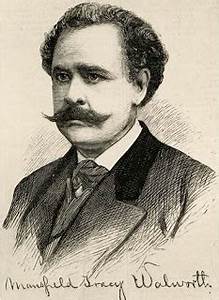
Mansfield Tracy Walworth (1830-1873): Mad Leads to Madness
He was not the sort of fellow you would invite to a soiree. Writers can often be complicated people, but Mansfield Tracy Walworth was beyond the pale even in literary circles. The son of New York State Chancellor Reuben Hyde Walworth, he was born into privilege in Saratoga Springs where the Walworths occupied a position of local royalty. An old family with a lot of money. And a dark side that carried Mansfield to his early death.
What was a state chancellor, you might ask? The job was a carryover from British rule when colonies had a court of chancery like they have in Mama England. Until the post was eliminated in 1846, Chancellor Walworth held great power as head of the state judiciary, and acted as a kind of judge at large. He traveled the state judging cases from small claims to capital crimes, and in 1825 he left three murdering brothers dangling from ropes in Niagara Square in Buffalo. He sent a young New York City woman to the gallows for the murder of her infant child, although there remained strong evidence that her lover was the guilty party. But the chancellor also sat on the Court for the Trial of Impeachments and Correction of Errors, which could act as a court of appeals, so it was tough to challenge his decisions. Like many prominent people of his time, he was a member of the Temperance Societies, as well as The Great Bible Tract.
But his own family was heading for sensational trouble, although the good chancellor, who died in 1867, was gone before the worst of it hit the paddle wheel.
His son Mansfield was a bright fellow who graduated from Union College in 1849 and became a lawyer, and then a writer of sensationalist novels, low-brow stuff that would have disappeared long ago if they had not written by such a notorious character. But in fact, Warwick, or the Lost Nationalities of America; Hotspur, a Tale of the Old Dutch Manor; and Lulu: A Tale of the National Hotel Poisoning, among others, are still available on line in both print and e-book format. The last was a fictionalization of a mysterious miasma which in January 1857 struck some four hundred guests of the National Hotel in Washington, DC, resulting in more than thirty deaths, including several congressmen and the nephew of the new president-elect James Buchanan, who also was taken ill. Arsenic was suspected as well as water-born bacteria, but the offending bug was never identified. The New York Times commented that his novels were “intended for and only bought by the numerous class of persons who admire glittering and gaudy descriptions and sentimental storytelling.”
Like his father, he was also a Confederate sympathizer, and during the Civil War he was caught in Washington in the company of a woman who was a suspected spy for the south. But wealth and privilege saved him from prison, and possibly even the gallows. He was released into the company of his father and ordered not to leave the house in Saratoga for the remainder of the war. Or else.
But allow me to back up a few years. In 1852, Mansfield married Ellen Hardin Walworth, the daughter of the chancellor’s second wife–in other words, he married his step-sister. That is actually legal everywhere in the US except Virginia. To everyone’s dismay, he turned out to be an abusive husband, both physically and verbally. After having five children, three daughters and two sons, and after several attempts at reconciliation, the couple divorced.
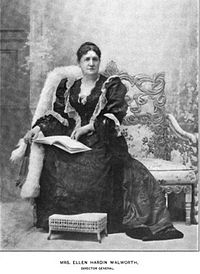
Mansfield moved to a boarding house in Manhattan, cut off from his family and his considerable inheritance. From there he wrote letters back to Ellen, threatening to beat and even kill her and the rest of his family. These were not mere angry letters, nor even the foments of an unrepentant brute; they were vile rants of a mentally ill and obviously dangerous man.
Eventually their nineteen-year-old son Frank, who suffered from epilepsy and was very close to his mother, began intercepting the letters and keeping them from her. He decided to take matters into his own hands, and on the morning of June 2, 1873, he boarded a train in Saratoga bound for Manhattan, and he left word at the boarding house for his father, asking him to come to his hotel room in the Sturtevant House.
The following morning, June 3, Mansfield knocked on his son’s door. What exactly was said between them no one knows, but Frank fired four shots into his father with his Colt revolver, and then promptly turned himself in to the police at the precinct station on Thirtieth Street between Sixth and Seventh Avenue. He walked calmly to the desk and said to the officer in command, “My name is Frank H. Walworth; I have just shot and killed my father, Mansfield T. Walworth in the Sturtevant House, and here is my pistol,” according to the The New York Times which called it “a case of unusual repulsiveness.”
Frank was remanded to the Tombs awaiting trial. And at the age of twenty, he received a life sentence for second degree murder. But this is where the story takes another extraordinary turn.
His mother, Ellen, was determined to win a pardon for her son on grounds of insanity. She decided, therefore, to study law, and graduated from New York University to practice in New York and Washington, DC. It paid off. Frank was pardoned in 1877 by Governor Lucius Robinson, bolstered by the opinion of doctors that he was indeed insane and that extended time in prison would lead to complete mental dissolution. He was freed, but his life was short: he died in 1886 from a lung disease contracted while in prison.
Yet, for all that, the murder of her husband liberated Ellen. She lived a long life as a lawyer and public servant, she wrote numerous articles on science and historic preservation, became an authority on the Saratoga battlefields, raised funds for the restoration of George Washington’s home in Mount Vernon, and was one of the four principal founders of the Daughters of the American Revolution (DAR).
Finding the Grave of Mansfield Tracy Walworth
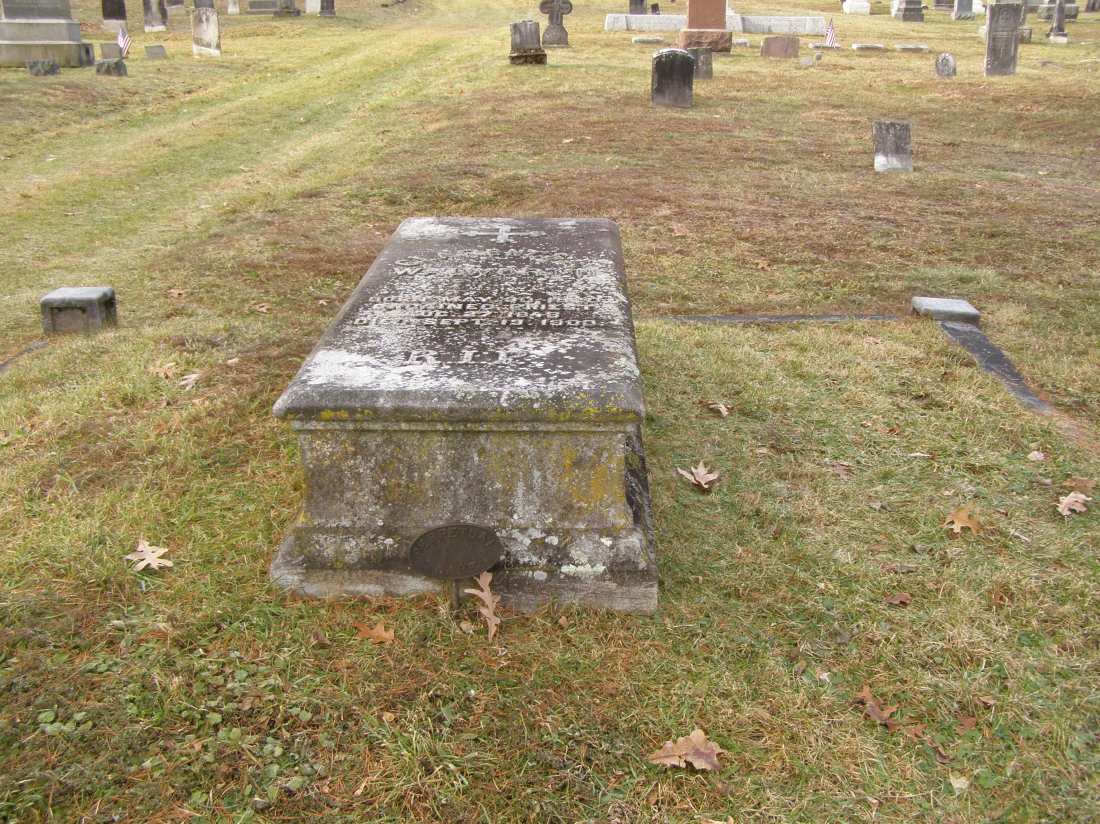
You can’t, not really. Several members of his family are buried in Greenridge Cemetery in Saratoga, and in fact he is too. But according to cemetery staff, they are not entirely sure where. They know he is buried in the Old Section A, near his older brother Clarence, who was a priest. But there is either no marker remaining, or the grave is marked by one of a couple stones nearby that are now illegible. Apparently, no one felt inspired to tend it. And he was such a nice guy!
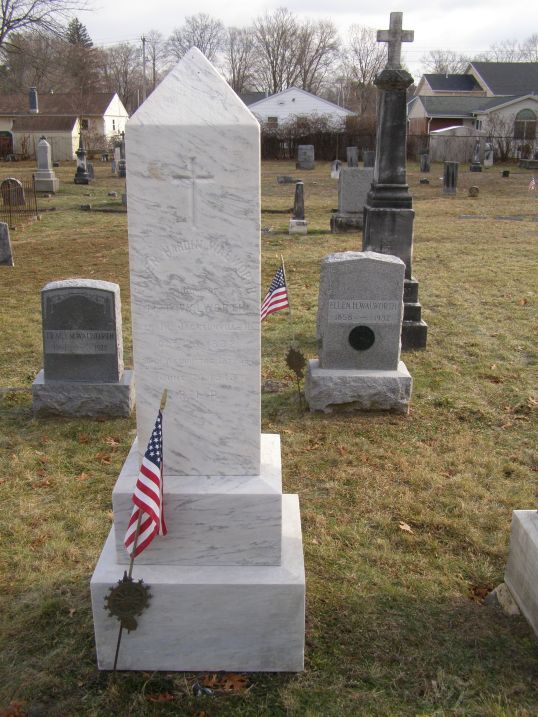
But Ellen’s grave is worth a visit. From South Broadway (Route 9), just a little south of the business district, turn east on Lincoln Avenue, and then very shortly turn right on Greenridge Place, a short cul de sac. At the very end of the street you will see the portals of Greenridge Cemetery. Greenridge is part New Section, and Part Old, which can be confusing, but these directions will get you to the spot.
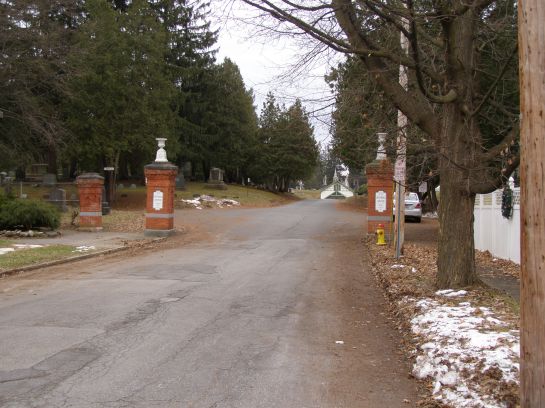
Once through the portals, turn left onto an unpaved path and stay on it as it takes a sharp turn to the left along the perimeter fence. Make a right turn passing behind the Civil War Memorial. Old Section B will be straight ahead. Stay on the path and stop next to the sign for Old Section A. A few strides away, and to your left, is the modest spire for Ellen Hardin Walworth. From the sign, follow the lane back directly to the area near the fence. There you will see Fr. Clarence’s crypt, and the area of grass under which lies the infamous Mansfield.
Sources
“A Terrible Parricide. Mansfield Tracy Walworth Killed by His Own Son—Surrender of the Murderer.” New York Times, June 4, 1873, p.8, web, accessed 12/8.18).; “The Four Founders,” DAR Daughters of the American Revolution, web, (accessed 12/8/18); “F. H. Walworth Pardoned. Governor Robinson Orders His Release,” New York Times, Aug. 2, 1877, web, (accessed 12/8/18); “The Walworth Patricide,” Murder by Gaslight, web, May 25, 2013 (accessed 12/8/18);
Text and cemetery photos, copyright © by Steven Huff
You’re making me smarter!
Judy 🐓
>
LikeLike
Thanks for sending this, Steve. Good job. Great fun to read. This guy lived practically in my back yard and I never knew about him.
William Patrick
1220 Lexington Avenue
Schenectady, NY 12309
H) 518-557-2342
C) 518-281-9911
LikeLike
Absolutely! It is bright and sunny and above freezing, thanks to my snow tires.
Sent from Outlook
________________________________
LikeLike